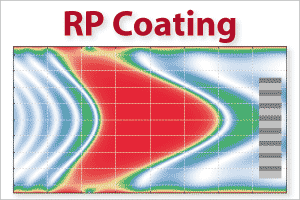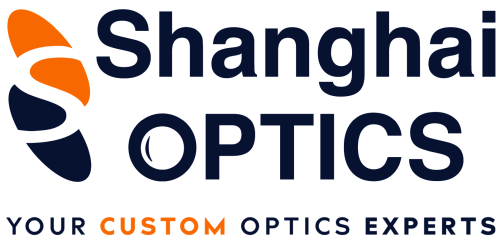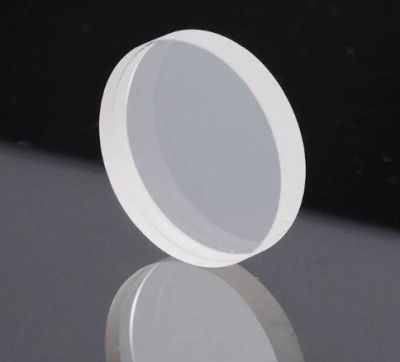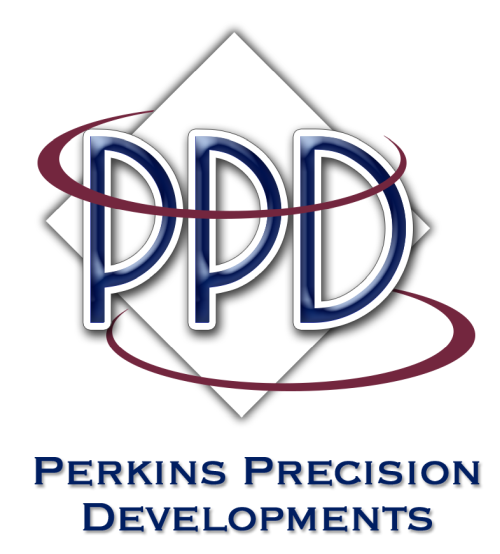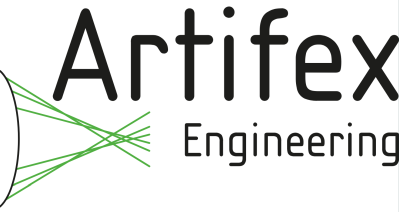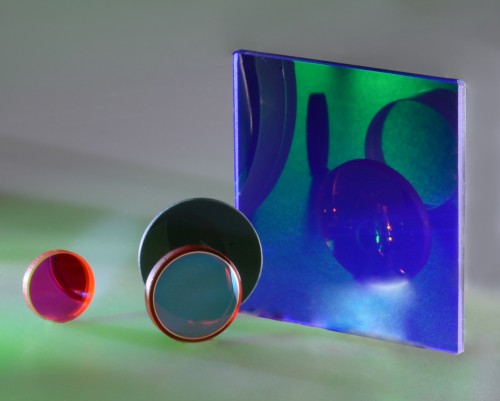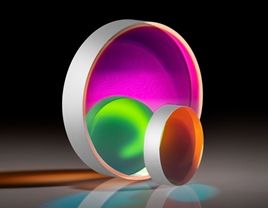dielectric mirrors (original) (raw)
Definition: mirrors consisting of multiple thin layers of different transparent optical materials
- mirrors
- metal-coated mirrors
- dielectric mirrors
* Bragg mirrors
* quarter-wave mirrors
* dichroic mirrors
* chirped mirrors
* cold mirrors
* hot mirrors - dispersive mirrors
- Bragg mirrors
- crystalline mirrors
- first surface mirrors
- parabolic mirrors
- variable reflectivity mirrors
- deformable mirrors
- laser mirrors
- laser line mirrors
- fiber loop mirrors
- semiconductor saturable absorber mirrors
- supermirrors
- (more topics)
Related: mirrorsmirror substrateslaser mirrorsBragg mirrorsdichroic mirrorschirped mirrorsdispersive mirrorsdielectric coatingsanti-reflection coatingsbeam splittersthin-film polarizersmetal-coated mirrorsResidual Transmission Through Highly Reflecting MirrorsReflection Spectrum of Tilted Dielectric Mirror
Page views in 12 months: 3546
DOI: 10.61835/8rr Cite the article: BibTex BibLaTex plain textHTML Link to this page! LinkedIn
Content quality and neutrality are maintained according to our editorial policy.
📦 For purchasing dielectric mirrors, use the RP Photonics Buyer's Guide — an expert-curated directory for finding all relevant suppliers, which also offers advanced purchasing assistance.
Contents
What are Dielectric Mirrors?
A dielectric mirror is a mirror based on multiple thin layers of (usually two) different transparent dielectric optical materials (→ dielectric coatings, thin-film coatings, interference coatings). Even if the Fresnel reflection coefficient from a single interface between two materials is small (due to a small difference in refractive indices), the reflections from many interfaces can (in a certain wavelength range) constructively interfere to result in a very high overall reflectance (reflectivity) of the device. The simplest and most common design is that of a Bragg mirror, where all optical layer thickness values are just one-quarter of the design wavelength. That design leads to the highest possible reflectance for a given number of layer pairs and given materials (assuming normal incidence). It is also possible to design dichroic mirrors with controlled properties for different wavelengths.
The higher the refractive index contrast of the layer materials, the smaller is the number of layer pairs required for a high reflectance, and the higher will be the reflection bandwidth.
More complicated multilayer structure designs can be used to obtain certain functions, such as
- a broader reflection bandwidth
- a combination of desirable reflectance values in different wavelength ranges
- special polarization properties (for non-normal incidence): thin-film polarizers, polarizing and non-polarizing beam splitters
- edge filters, e.g. long-pass filters, high-pass filters, band-pass filters
- tailored chromatic dispersion properties (see the article on dispersive mirrors)
The number of thin-film layers required depends very much on the required function and on the refractive index difference between the coating materials. Few layer pairs are sufficient in some cases, whereas more than 100 layers are required in other cases.
The resonator mirrors of a laser are almost always dielectric mirrors because such devices routinely achieve a very high reflectance of > 99.9%, and their limited reflection bandwidth can be convenient because it allows the transmission of pump light (at a shorter wavelength) through a folding mirror of the resonator (→ dichroic mirrors). Dielectric mirrors used for lasers and for reflecting laser beams are often called laser mirrors.
A characteristic property of dielectric mirrors is that their optical properties depend substantially on the angle of incidence. As an example, Figure 1 shows reflectance spectra of a simple Bragg mirror for different incidence angles. The larger that angle, the more the reflection spectrum is shifted towards shorter wavelengths. This is essentially because the component of the wave vector perpendicular to the layer surfaces becomes smaller for a given wavelength, which can be compensated by reducing the wavelength [10].

Figure 1: The reflectance spectrum of a Bragg mirror for different incidence angles from normal incidence (red) up to 60° (blue) in steps of 10°.
Optimized Bragg mirrors, also called supermirrors, can even have much higher reflectivities — in extreme cases, even larger than 99.9999%, allowing e.g. the construction of optical resonators (cavities) with extremely high Q-factor. Such performance requires high-quality mirror coatings with very low absorption and scattering, also with high uniformity of the layer thickness.
As dielectric mirrors usually provide a high reflectance at most in a smaller part of the visible spectrum, they often do not appear like other mirrors such as silver mirrors (or other metal-coated mirrors), as used in households: dielectric mirrors are usually transparent to visible light and shine in colors which depend on the angle of view. It can even be difficult to see which side of the substrate has the mirror coating.
Dielectric multilayer mirrors can be made on both plane and curved surfaces. In the latter case, the mirrors are focusing or defocusing. For example, a concave surface with radius of curvature ($R$) focuses with a focal length ($R / 2$) for normal incidence. For small radii of curvature (e.g. below 10 mm), there may be problems with the coating quality in terms of homogeneity and stability.
Calculating Mirror Properties
The reflection properties (including the dispersion) of a dielectric multilayer mirror can be calculated with modeling software e.g. based on a matrix method, where each layer is associated with a 2-by-2 complex matrix, and all matrices are multiplied together to result in a matrix of the whole layer structure. From that matrix, the complex amplitudes of reflected and transmitted waves can be calculated, and also the field distribution within the structure. The chromatic dispersion properties result from the frequency dependence of the complex reflection or transmission coefficients, which can be calculated based on the Fresnel equations.
Some non-trivial mathematical aspects come into play when materials are absorbing. A problem can also be to obtain sufficiently precise material data, particularly for materials where the obtained refractive index has a significant dependence on the fabrication method (see below).
In most cases, the optical intensities within dielectric mirrors are too low to cause substantial changes in the refractive index. In some special cases, however, the Kerr effect becomes significant [5, 6]. Here, one may apply an iterative numerical procedure, where after each step the refractive index profile of the coating structure is updated according to the calculated optical intensities.
Designing Dielectric Mirrors
It can be a difficult task to find a dielectric mirror design which satisfies certain criteria, such as
- a combination of reflectivities at different wavelengths
- very broadband reflection ranges
- anti-reflection properties
- certain polarization properties (for non-normal incidence; → thin-film polarizers)
- a certain chromatic dispersion profile
- minimum sensitivity to growth errors
Such dielectric mirror designs can often only be found by using numerical optimization algorithms, although analytical design strategies are known for some design targets (e.g. chirped mirror designs for dispersive mirrors). Technical challenges arise from the high dimensionality of the searched parameter space, and from the myriads of local optima which make it difficult to find the global optimum. An efficient optimization requires advanced mirror design software with features like efficient multi-dimensional optimization with Monte Carlo methods, definition of sophisticated figure-of-merit functions (also taking into account the sensitivity to growth errors), etc.
Beyond the technical optimization problems, there are of course also fundamental limitations. In many cases, the design involves a compromise between the obtained optical properties, the required number of layers, and the required growth precision.
For details on the fabrication of dielectric mirrors, see the article on dielectric coatings.
Designing Dielectric Mirrors
For designing multilayer mirror coatings, a flexible simulation and design software is indispensable. It must not only be able to calculate all relevant optical properties for a given design, but assist you in finding a suitable design for achieving given target properties. The RP Coating software is an ideal tool for such work, as it is particularly flexible. For example, you can define a figure of merit, formulating the optimization goal, of any conceivable kind.
Long Wavelengths
Dielectric mirrors are mostly used for the visible, ultraviolet and near infrared spectral region. For a rather long wavelength radiation, e.g. light at 10.6 μm from CO2 lasers, it is hard to fabricate well-performing dielectric mirrors due to a lack of suitable dielectric materials. Note that these do not only need to exhibit sufficiently small absorption, but must also be suitable for controlled deposition on a mirror. Therefore, metal-coated mirrors instead of dielectric mirrors are widely used in infrared optics.
Frequently Asked Questions
This FAQ section was generated with AI based on the article content and has been reviewed by the article’s author (RP).
What is a dielectric mirror?
A dielectric mirror consists of multiple thin layers of different transparent dielectric materials on a substrate. Reflections from the many layer interfaces are designed to constructively interfere, resulting in a very high overall reflectance in a specific wavelength range.
What is a Bragg mirror?
A Bragg mirror is the simplest and most common type of dielectric mirror. In this design, each layer has an optical thickness of one-quarter of the target wavelength, which maximizes the reflectance for a given set of materials and number of layers.
Why are dielectric mirrors ideal for lasers?
They are ideal for lasers because they can achieve extremely high reflectance (often >99.9%), minimizing losses within the laser resonator. Also, their specific reflection bandwidth allows them to reflect the laser light while transmitting pump light at another wavelength.
How does the angle of incidence affect a dielectric mirror?
As the angle of incidence increases from normal (0°), the reflection spectrum of a dielectric mirror shifts towards shorter wavelengths. Therefore, their performance is highly dependent on the angle at which they are used.
What is the main advantage of dielectric mirrors over metal-coated mirrors?
The main advantage is their ability to achieve much higher reflectance (e.g., >99.9%) with very low absorption and scattering losses. This is crucial for applications like high-performance lasers where minimizing optical loss is essential.
Can dielectric mirrors be used to focus light?
Yes, the dielectric multilayer coatings can be applied to curved substrates. A mirror with a concave surface will focus light, while one with a convex surface will defocus it, with a focal length determined by its radius of curvature.
Suppliers
Sponsored content: The RP Photonics Buyer's Guide contains 128 suppliers for dielectric mirrors. Among them:
💻 software💡 consulting
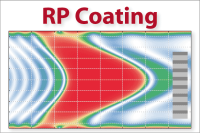
With the powerful software RP Coating, you can analyze and optimize optical thin-film multilayer coatings. The great flexibility of that software allows you, for example, to define an arbitrary figure-of-merit function describing your requirements.
⚙ hardware
Shanghai Optics is a custom optics manufacturer with over 55 years of optics manufacturing experience. We produce high precision broadband dielectric mirrors according to customer’s specifications. These mirrors have the same exceptional specifications as our laser mirrors except that they use special multi layer coatings to achieve a very high degree of reflectance for both s- and p-polarizations over a broad wavelength range. For white light or tunable laser use these mirrors provide the ultimate in high reflectance and insignificant polarization effect. The reflectance of these coatings is consistently greater than 99.5% average. However, this figure includes very small dips in the p-reflectance which can never be completely eliminated. The s-polarization component has a reflectance greater than 99.9% over the entire range.
⚙ hardware
OPTOMAN concentrates on a single manufacturing technology — ion beam sputtering (IBS). We are ready to develop cost effective yet advanced, high accuracy and repeatability dielectric mirror coatings optimized for your application. Our dielectric mirrors are available in multiwavelength or broadband configuration in spectral range from 193 nm up to 5000 nm.
Standard in-stock mirrors designed for ultrafast applications can be found in OPTOSHOP.
⚙ hardware
Perkins Precision Developments (PPD) manufactures high energy laser mirrors and precision optics for both prototype and volume OEM requirements. We also offer custom Ion Beam Sputtered (IBS) thin film coatings for visible to near-infrared wavelengths on customer supplied substrates. PPD utilizes IBS coating technology because it is ideal for complex spectral designs, high power lasers and applications where it is critical to minimize losses from absorption and scatter.
Typical mirror coatings include dielectric low-loss high reflectors (HR), multi-wavelength high reflectors, dichroic mirrors, trichroic mirrors and beam splitter mirrors.
⚙ hardware
Artifex Engineering offers custom dielectric mirrors tailored to your requirements. Dielectric coatings are particularly developed for the respective application and enable precise wavelength ranges, so that individual wavelengths or selected ranges can be specified. Our mirrors can be manufactured in almost any shape: round, rectangular, elliptical, or any other shape including cut-outs and drill holes. Holes may also be drilled at an angle to the surface normal. Visit our product page for more information. We look forward to your inquiry.
⚙ hardware
LASEROPTIK can produce a wide range of laser mirrors with high reflectivity (HR) or partial reflectivity at given wavelength. We can also make specialty mirrors, e.g. with extremely broad reflection bands.
We use different coating technologies depending on your detailed requirements.
⚙ hardware
Our dielectric mirrors have the same exceptional specifications as our laser mirrors, except that they use special multi-layer coatings to achieve a very high degree of reflectance for both s- and p-polarizations over a broad wavelength range.
⚙ hardware
Edmund Optics offers a range of laser mirrors for use from the extreme ultraviolet (EUV) to the far IR. Laser mirrors designed for dye, diode, Nd:YAG, Nd:YLF, Yb:YAG, Ti:sapphire, fiber, and many more laser sources are available as flat mirrors, right angle mirrors, concave mirrors, and other specialty shapes. Ultrafast laser line mirrors designed to provide high reflection with minimal group delay dispersion (GDD) for femtosecond pulsed lasers including Er:glass, Ti:sapphire, and Yb:doped laser sources are also available.
⚙ hardware
Knight Optical can provide catalogue dielectric front surface mirrors with coatings optimised for the visible or NIR regions, offering over 98% reflection in these wavelengths. Also available are laser mirrors with a dielectric coating applied using ion beam sputtering (IBS) technology, with above 99.9% reflection at their dedicated wavelength. Custom dielectric mirrors are available upon enquiry.
⚙ hardware🧩 accessories and parts🧴 consumables🔧 maintenance, repair📏 metrology, calibration, testing💡 consulting🧰 development
Shalom EO offers a wide selection of off-the-shelf and custom dielectric mirrors, including:
- laser line dielectric mirrors: suitable for various laser types, including Nd:YAG, LD laser, HeNe, ytterbium laser, alexandrite, etc. Laser-line optimized reflectance >99.8% ((Rs + Rp) / 2) at 0° or 45° AOI. Broadband options are also available.
- output couplers: diverse reflection/transmission wavelength configurations
- high power laser mirrors: laser line, high power OC mirror, dichroic mirror
- femtoline low GDD mirrors, we can provide low GDD of ±20 fs2 and high reflectance of >99.9% ((Rs + Rp) / 2)
Shalom EO’s pre-defined dielectric mirror coatings ensure the desired reflectance, ideal for obtaining optimum power output from the laser cavities or precise beam steering. The laser line dielectric mirrors and high-power laser mirrors are made of Corning UV-grade fused silica or other materials. High precision is achieved with high surface flatness of λ/10.
Besides the conventional dielectric mirrors, Shalom EO also specializes in offering other special dielectric mirrors for more demanding applications, such as chirped mirrors for ultrafast and femtosecond lasers.
⚙ hardware
We offer dielectric laser mirrors for fixed, narrowband or broadband applications covering the UV, VIS and IR spectral regions. Wide selection of round, elliptical or custom shapes as well as plano, spherical, cylindrical surface mirrors and substrates are available.
Bibliography
| [1] | J. A. Dobrowolski and D. G. Lowe, “Optical thin film synthesis program based on the use of Fourier transforms”, Appl. Opt. 17 (19), 3039 (1978); doi:10.1364/AO.17.003039 |
|---|---|
| [2] | J. A. Dobrowolski and R. A. Kemp, “Refinement of optical multilayer systems with different optimization procedures”, Appl. Opt. 29 (19), 2876 (1990); doi:10.1364/AO.29.002876 |
| [3] | A. V. Tikhonravov et al., “Application of the needle optimization technique to the design of optical coatings”, Appl. Opt. 35 (28), 5493 (1996); doi:10.1364/AO.35.005493 |
| [4] | A. V. Tikhonravov et al., “Phase properties of multilayers”, Appl. Opt. 36 (19), 4382 (1997); doi:10.1364/AO.36.004382 |
| [5] | E. Fedulova et al., “Kerr effect in multilayer dielectric coatings”, Opt. Express 24 (19), 21802 (2016); doi:10.1364/OE.24.021802 |
| [6] | T. Amotchkina, M. Trubetskov and V. Pervak, “Experimental and numerical study of the nonlinear response of optical multilayers”, Opt. Express 25 (11), 12675 (2017); doi:10.1364/OE.25.012675 |
| [7] | A. Rudelis et al., “Degradation of Ta2O5 / SiO2 dielectric cavity mirrors in ultra-high vacuum”, Opt. Express 31 (24), 39670 (2023), doi:10.1364/OE.504858 |
| [8] | A. Thelen, Design of Optical Interference Coatings, McGraw–Hill (1989) |
| [9] | N. Kaiser (ed.), Optical Interference Coatings, Springer, Berlin (2003) |
| [10] | R. Paschotta, “Reflection spectrum of tilted dielectric mirror”, The Photonics Spotlight 2006-11-02 |
(Suggest additional literature!)
Questions and Comments from Users
Here you can submit questions and comments. As far as they get accepted by the author, they will appear above this paragraph together with the author’s answer. The author will decide on acceptance based on certain criteria. Essentially, the issue must be of sufficiently broad interest.
Please do not enter personal data here. (See also our privacy declaration.) If you wish to receive personal feedback or consultancy from the author, please contact him, e.g. via e-mail.
By submitting the information, you give your consent to the potential publication of your inputs on our website according to our rules. (If you later retract your consent, we will delete those inputs.) As your inputs are first reviewed by the author, they may be published with some delay.
 photonic devices
photonic devices